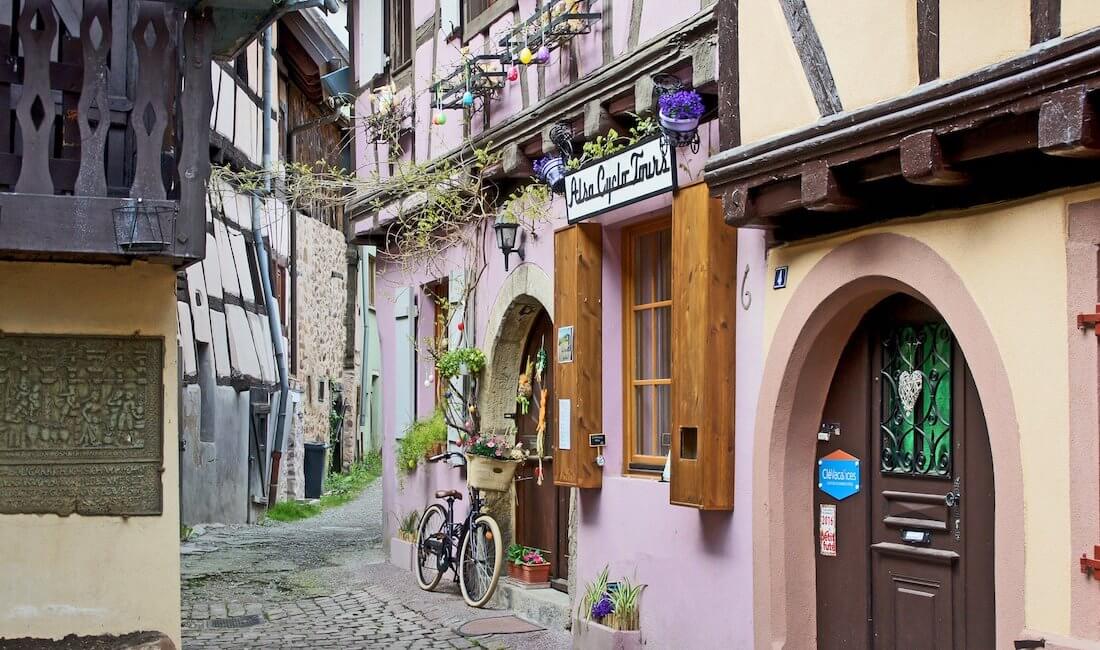Unsure about your French table manners? Click Here to download > > How to avoid these 10 food etiquette mistakes !
- Home ›
- Destinations ›
- Departments of France
The 101 Departments In France (and a bit about them)
Updated 10 August 2025 by Leyla Alyanak — Parisian by birth, Lyonnaise by adoption, historian by passion
France is divided into administrative units called departments, which are grouped into larger French regions. This guide explains how they’re organized, so you can better understand maps, addresses, and local references when you travel.
The 101 departments in France are grouped into 18 regions (read about those here) but each department is distinct, often with its own foods and traditions and, of course, scenery.
For foreigners, they can be explained as districts of France, or even French provinces, but here, they are called départements.
What are French departments and why should we care?
As good French schoolchildren, we’re supposed to know every French department by heart, but we don’t — except for those near where we live or spend our summer holidays.
A département (department in French) is an administrative unit, with regions above it and communes (towns or villages) below.
A department can also be subdivided into smaller parts of France, but that’s purely administrative. These segments — like cantons or arrondissements — aren’t used often enough to worry about.
The first 83 French departments were created in 1790, at a time of huge turmoil: the Bastille had just been stormed, and Louis XVI had begun his slide toward the guillotine (that would happen in early 1793).
But efforts to consolidate France were also moving forward, and the departments were part of this. They were designed to be roughly the same size, with each capital no more than a day’s horseback ride from the farthest corners of the department.
But please wait a while before getting that map tattoo. Things will change again someday, I promise.
How many departments in France?
France is divided into 101 départements — from mainland regions to overseas territories — and knowing their names or numbers can be surprisingly useful
It's always good to have an idea of the name or number of your favorite departments, yours, for example, or those nearby.
In France we often use the numbers to refer to them... for example, you're going skiing in the village of St Bumpkin? A friend might ask, "Is that in the 74?" What they really mean is: "Is that in the département of the Haute-Savoie?"
There is no hard and fast rule. Sometimes we use numbers, sometimes names, sometimes smaller areas within departments that are known and meaningful, but not official.
For example, I live in the Bugey, in the Ain, the 01. If I'm talking to someone on the other side of France, I'll call it the Ain or the 01. But if I'm talking to someone from the Ain, chances are they'll know the beautiful Bugey, famous for its chickens, cliff climbing and stunning rivers.
The map of France departments and the list below should help make sense of it all. Or confuse you further.

As I travel through France, I write about each of these departements.
Be the first to read these stories by subscribing to my free newsletter, Beyond the Baguette, where I tell you all sorts of interesting things and point you to the latest posts on this site.
And now, here's France, in all its illogical glory: regions, and each department within it.
Complete list of French departments
The following is a list of all the regions of France and their respective departments, or départements, along with each department's number. I've visited many of these but haven't written about them all – but I'm working on it.
Where available, click the link to explore my in-depth guide for that department.
Auvergne-Rhône-Alpes
Ain (01)
Allier (03)
Ardèche (07)
Cantal (15)
Drôme (26)
Isère (38)
Loire (42)
Haute-Loire (43)
Puy-de-Dôme (63)
Rhône (69)
- Antique Lyon Roman Ruins
- Halles Paul Bocuse Lyon Food Market (Where Top Chefs Love To Shop)
- Ode To Croix-Rousse, Lyon's Bohemian Silk Weaving Hill
- 16 Terrific Day Trips From Lyon Into The Heart Of France
- Weird, Whimsical And Wonderful Facts About Lyon, France
- The Lyon Astronomical Clock: A Magical 650-Year-Old Timepiece
- Lyon In December Or – What Is Lyon In Winter Really Like?
- Lyon Light Festival: The Exhilarating Fête Des Lumières
- How to Use Public Transportation in Lyon
- Everything You Need to Know About Renting a Car in Lyon
- What Is Lyon Famous For?
- The Monumental Murals of Lyon
- Fourviere Hill: Basilica, Ruins, And The Best View Of Lyon
- Irresistible Things To Do In Lyon France
- Uncover Famous Secret Passages: The Traboules Of Lyon
- 8 Best Hotels Near Lyon Train Station
- Perouges, The Medieval Village They Almost Razed
- The 7 Best Lyon Food Tours In France’s Gastronomic Capital
- 13 Reasons They Call Lyon "Food Capital Of The World"
- Affordable Michelin-Starred Dishes At The Lyon Street Food Festival
Savoie (73)
Haute-Savoie (74)
- Nostalgia In Evian-Les-Bains, Where The Belle Epoque Still Lives
- What To Do In Annecy, France's Prettiest Town
- 17 Outstanding Day Trips From Annecy By Car Or Train
- Yvoire, France: A Most Picturesque Medieval Village On Lake Geneva
- 5-Day Lake Geneva And French Alps Road Trip Itinerary
Bourgogne-Franche-Comté
Côte-d'Or (21)
- How The City Of Dijon Lost Its Mustard
- Chateau Bussy Rabutin And The Salacious Story Of The Count Who Lived There
- The Quirkiest Dijon Museum: A Peek At 19th-Century Burgundian Life
- Flavigny-Sur-Ozerain, Where Chocolat Was Filmed
- The Auxois: A Perfect Day Trip from Dijon
- The Dijon Owl's Trail
Doubs (25)
Jura (39)
Nièvre (58)
Haute-Saône (70)
Saône-et-Loire (71)
Yonne (89)
Territoire de Belfort (90)
Bretagne
Côtes-d'Armor (22)
Finistère (29)
Ille-et-Vilaine (35)
Morbihan (56)
Centre-Val de Loire
Cher (18)
Eure-et-Loir (28)
- Chateau de Maintenon and the Astonishing Rise of Françoise d'Aubigné
- La Maison Picassiette In Chartres: The House Of A Million Pieces
- 3 Fascinating Castles Near Paris That Are Way Under The Radar
- Chateau D'Anet: The Love Nest Of Henri II And Diane
- The Chartres Cathedral Labyrinth (And Other Fascinating Wonders)
Indre (36)
Indre-et-Loire (37)
- How Two Remarkable Women Fought Over Chenonceau Castle
- Chinon Castle: Tales Of Heresy, Betrayal, And Liberation
Loir-et-Cher (41)
Loiret (45)
Corse (Corsica)
Corse-du-Sud (2A)
Haute-Corse (2B)
Grand Est
Ardennes (08)
Aube (10)
Marne (51)
Haute-Marne (52)
- Voltaire In Love: The Improbable Power Couple Of The Chateau De Cirey
- The Memorial Charles De Gaulle: Home, Life And Times Of A French Hero
- 9 Unexpected Things To Do In Haute-Marne
- Discovering Langres, The Prettiest French Town You've Never Heard Of
Meurthe-et-Moselle (54)
- France's Favorite Square: The Secrets Of Place Stanislas, Nancy
- 5 Unmissable Highlights Of The Ecole De Nancy Art Nouveau
Meuse (55)
Moselle (57)
Bas-Rhin (67)
Haut-Rhin (68)
Vosges (88)
Hauts-de-France
Aisne (02)
Nord (59)
Oise (60)
Pas-de-Calais (62)
Somme (80)
Île-de-France
Paris (75)
- Tours about the French Revolution in Paris
- The Haunted Catacombs of Paris
- 10 Most Charming Hotels Near Versailles Palace, France
- Top 5 Tours of the Paris Catacombs
- Best Paris Ghost Tours
- 7 Tempting Things to Do in Paris in Autumn
- 11 Festive Things To Do In Paris In December [2023]
- Winter in Paris: Is This the Best Season to Visit?
- 8 Free Things To Do In Paris You Won't Find On Every List
- 24 Attractions That Are Off The Beaten Path In Paris
- Pickpockets In Paris: How To Avoid Getting Robbed
- 9 Eminently Haunted Places In Paris
- The Magnificent Comeback Of The Paris Bouillon Restaurants
- Secrets Of The Eiffel Tower
- 8 Best Spa Hotels In Paris With Perfect Location And Luxury
- 15 Quirky Facts About The Most Famous Roundabout In Paris
- 3 Dangerous Areas In Paris You Should Avoid
- 10 Cool Paris Hotels: A Zany Guide To Unique Hotels In Paris
- The Counterfeit Museum of Paris, Where Fakes Look Real
- 10 Best Hotels With Balcony: Paris With A Glorious View
- 7 Non-Touristy Things to Do in Paris
- 22 Fabulous Day Trips from Paris by Train
- Best Paris Food Tours
- Dark Tourism In Paris: 6 Sites That May Unnerve You
- Is Paris Safe? 4 Myths That Need Debunking In 2023
- 6 Magical Ways To Experience Paris In Spring
- 11 Masterpieces Of The Cluny Museum (Including Lady And The Unicorn)
- 5 Paris Museums That Are Rarely Crowded And Always Remarkable
- How to Plan Your Trip To The Carnavalet Museum in Paris
- In the Footsteps of Napoleon III: A Walk Through Second Empire Paris
Seine-et-Marne (77)
Yvelines (78)
Essonne (91)
Hauts-de-Seine (92)
Seine-Saint-Denis (93)
Val-de-Marne (94)
Val-d'Oise (95)
Normandie
Calvados (14)
- Visiting The D Day Beaches? This Is The Only Guide You'll Need
- Bayeux, France: Vikings, Conquerors And The Roar Of Tanks
Eure (27)
Manche (50)
Orne (61)
Seine-Maritime (76)
- 12 Things To Do In Rouen, Normandy That Will Enrich Your Culture
- Rouen, Capital Of Impressionism? Light, Shadow, And The River Seine
- 7 Thematic Ways To Explore Rouen Cathedral, A Gothic Masterpiece
- In The Footsteps Of Joan Of Arc In Rouen
- 4 Culinary Treasures Of Rouen
Nouvelle-Aquitaine
Charente (16)
Charente-Maritime (17)
Corrèze (19)
Creuse (23)
Dordogne (24)
Gironde (33)
- Bordeaux Roman Ruins: A Glimpse Of Rich Historical Past
- 14 Tempting Reasons To Visit Bordeaux (it's not just the wine)
Landes (40)
Lot-et-Garonne (47)
Pyrénées-Atlantiques (64)
- Things To Do In Bayonne: Culture, Cloisters, And Chocolate
- How To Tour The Basque Country Of France In A Week (Or Less)
- 7 Surprising Basque Products That Are Still Made By Hand
- The Fearless Corsairs And Legendary Basque Legacy Of Saint Jean De Luz
- Things to Do in Biarritz If You Love History and Culture
Deux-Sèvres (79)
Vienne (86)
Haute-Vienne (87)
Occitanie
Ariège (09)
Aude (11)
Aveyron (12)
Gard (30)
Haute-Garonne (31)
Gers (32)
Hérault (34)
Lot (46)
Lozère (48)
Hautes-Pyrénées (65)
Pyrénées-Orientales (66)
Tarn (81)
Tarn-et-Garonne (82)
Pays de la Loire
Loire-Atlantique (44)
Maine-et-Loire (49)
Mayenne (53)
Sarthe (72)
Vendée (85)
Provence-Alpes-Côte d'Azur
Alpes-de-Haute-Provence (04)
Hautes-Alpes (05)
Alpes-Maritimes (06)
- A Guide To Grasse, France: Perfume Capital Of The World
- The Baroness, The Gigolo, And The Villa Ephrussi De Rothschild
- 10 Delicious French Riviera Food Dishes To Taste In Nice, France
- The Escoffier Museum: An Ode to the Master Chef
Bouches-du-Rhône (13)
- The Arles Amphitheater: 10 Great Roman Monuments of Arles
- Follow in the Footsteps of Vincent van Gogh
- 5 Unrivaled Marseille Museums That Are Worth YourVisit
- The Fascinating "True" Story Of The Legendary Chateau D'If
- How To Get Around Marseille As A Tourist
- Is Marseille Safe? Or Is The City As Dangerous As They Say?
- How Marseille Soap Is Making A Comeback - And Why It's A Problem
- How To Make The Best Of One Day In Marseille
Var (83)
Vaucluse (84)
- Is Avignon Bridge The Most Famous Bridge In France?
- Myths and Legends of the Luberon
- Mur De La Peste: When The Epidemic Struck, They Built A Wall
- Five Breathtaking Hilltop Villages In Provence's Luberon
- 6 Perfect Things To Do In Avignon In One Day
- Lacoste Village: Scandal, Style, And A Steamy History
- Don't Miss These 7 Spectacular Sights in Saint Remy de Provence
- Bonnieux, France: Heart of the Luberon
- Roussillon, Luberon, And The Magic Of Ochre
- The Best 5-Day Luberon Itinerary
- If You Love Antiques, Head For Isle sur la Sorgue In Provence
- How to Visit the Luberon without a car
France's overseas possessions
These regions are not in Metropolitan France (meaning they are located on other continents) but are fully integrated politically into France — they pay taxes, send representatives to the National Assembly, and so on:
- Guadeloupe
- Martinique
- Guyana
- La Réunion
- Mayotte
Because of history, France also has a set of overseas possessions in various categories that you might not realize are officially part of the country:
- Overseas collectivities: French Polynesia (think Tahiti), Saint Pierre et Miquelon (off the coast of Newfoundland in Canada), Wallis and Futuna (in the Pacific between Fiji and Samoa), and Saint Martin and Saint Barthélemy, both well-known Caribbean vacation spots. Each sends deputies to the National Assembly.
- Overseas territories: French Southern and Antarctic Lands, plus a few scattered islands in the Indian Ocean.
- New Caledonia: a unique case with special status — part French, part independent.
- Clipperton Island: a tiny, state-owned enclave off the coast of Acapulco, uninhabited, with no clear decision on its future use.

Why do we even have departments in France?
The idea of départments has a long history.
We first floated the idea to our king, Louis XIV, in 1655, but it took until the French Revolution to sort things out. At that time, France was a patchwork of administrative, military, religious, legal, and fiscal territories that overlapped one another.
Finally, in 1789, the Revolution brought some order to the confusion and created 83 departments. Their sizes were calculated so one could ride from anywhere in the department to its capital on horseback in less than a day.
Today, some departments are urban, others rural, and their size varies widely.
In densely populated ones, you can cross the entire department in half an hour on a bus or tram.
In rural areas like mine, it can take an hour and a half to reach the capital.
Given France’s love of paperwork (you can thank Napoleon Bonaparte for that), you may have to make the trip the department's capital (or main préfecture) more often than you’d like — and without a car, it could mean half a day on public transport.
Most departments are named after rivers or mountains, with a few exceptions such as Savoy, which likes to go its own way and sometimes pretends it’s not part of France at all.
Department numbers have two digits, except Corsica, which uses one digit and one letter (2A and 2B), and the overseas departments, which have three digits. A uniform numbering system might have been simpler...

